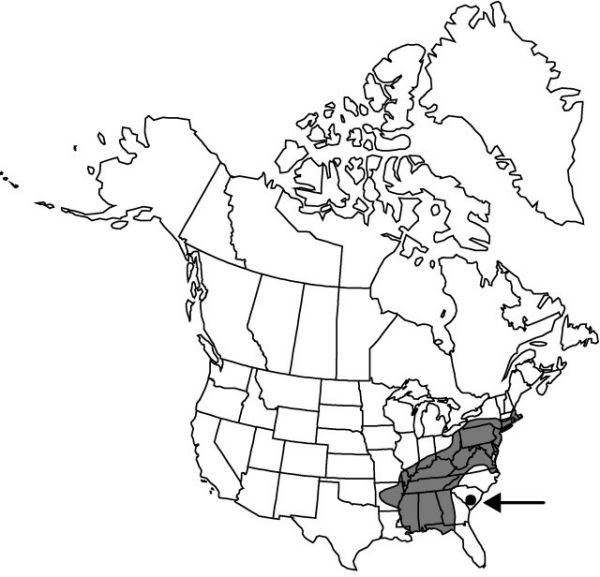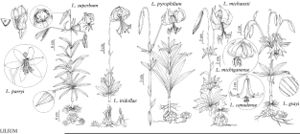Lilium superbum
Sp. Pl. ed. 2, 1: 434. 1762.
Bulbs rhizomatous, often branching dichotomously at 120° from main axis, 2.4–4.3 × 6–10.2 cm, 0.2–0.6 times taller than long, 2 (–3) years’ growth evident as annual bulbs, the scaleless sections between these 0.6–3.8 (–4.6) cm; scales 1–2-segmented (if 2-segmented, often only on inner scales), longest 1.2–3.9 cm; stem roots present or absent. Stems 1.2–2.8 m. Buds ± triangular in cross-section. Leaves usually ± evenly distributed along stem, in 6–24 whorls or partial whorls, 3–20 leaves per whorl, usually ± horizontal and drooping at tips, distal leaves ascending in sun, 7.1–26.1 × 0.7–2.7 cm, 4–18 times longer than wide; blade narrowly elliptic, sometimes extremely so, occasionally barely oblanceolate, margins not undulate, apex acute, acuminate in distal leaves; veins and margins ± smooth abaxially. Inflorescences racemose, 1–22-flowered. Flowers pendent, not fragrant; perianth Turk’s-cap-shaped; sepals and petals reflexed less than 1/5 along length from base, yellow or sometimes yellow-orange proximally, red-orange or sometimes red, red-purple, orange, or yellow barely suffused with red distally, spotted magenta, not distinctly clawed, nectaries exposed, forming visible green star; sepals with 2 parallel, often faint abaxial ridges, 6.8–10.5 × 1.1–2.1 cm; petals 7–10.2 × 1.4–2.6 cm; stamens strongly exserted; filaments parallel along much or most of length, then widely spreading, diverging (7°–) 11°–30° from axis; anthers magenta, occasionally purple or dull purple, 1.4–2.6 cm; pollen rust; pistil 4.7–8.2 cm; ovary 1.5–3.4 cm; style pale green, often spotted purple; pedicel 7.4–19.1 cm. Capsules 2.9–6.2 × 1.7–2.5 cm, 1.7–3.3 times longer than wide. Seeds not counted. 2n = 24.
Phenology: Flowering summer (Jul–early Aug).
Habitat: Gaps and openings in rich woods, swamp edges and bottoms, streamsides, moist meadows and thickets, balds, pine barrens, roadsides
Elevation: 0–1600 m
Distribution

Ala., Ark., Conn., Del., D.C., Fla., Ga., Ill., Ind., Ky., La., Md., Mass., Miss., Mo., N.H., N.J., N.Y., N.C., Ohio, Pa., R.I., S.C., Tenn., Va., W.Va.
Discussion
The largest Lilium east of the Rocky Mountains and the commonest over most of its range, the Turk’s-cap lily is a familiar sight throughout much of the southern Appalachians and along the northern Atlantic coastal plain. Flowers are rather variable; those in the north are sometimes floridly colored with dark purple bases on the perianth parts. The single report from Vermont (F. C. Seymour 1993) remains unconfirmed; however, recent collections from Washington Parish in Louisiana, Perry County in Missouri, and Bamberg County in the coastal plain of South Carolina extend the range of this species.
Lilium superbum shares distinctive features with L. michauxii, L. pyrophilum, and L. iridollae that indicate a close relationship and are diagnostically useful, namely paired ridges on the backs of the sepals and buds that are triangular in cross section. None has the red style characteristic of the other eastern pendent lily clade (L. michiganense, L. canadense, and L. grayi) centered to the northwest, and only L. iridollae sometimes has the leaf margins and veins roughened abaxially as is characteristic of L. canadense and its close relatives.
Common inheritance of a suite of unique, derived features and peripheral allopatric distributions suggest that Lilium pyrophilum and L. iridollae may be geographical isolates of broadly distributed L. superbum ancestral stock; both restricted species occur in specialized wetland habitats. Geography aside, the three are unequivocally distinguished only by various combinations of leaf and bulb characteristics, flower color, habitat, and blooming time. However, the overall degree of separation is comparable to that between many other species in the genus. Lilium superbum blooms the earliest, is the largest, and has the most numerous and largest flowers, and the long, narrow leaves in many whorls are distinctive. Lilium michauxii overlaps in range with these three species but is easily separated morphologically and ecologically.
Lilium superbum is pollinated primarily by the swallowtail butterflies that are common within its range, among them the spicebush (Papilio troilus Linnaeus, family Papilionidae), pipevine (Battus philenor Linnaeus), and eastern tiger (Papilio glaucus Linnaeus). Great spangled fritillaries [Speyeria cybele (Fabricius), family Nymphalidae] also visit the Turk’s-cap lily (R. M. Adams and W. J. Dress 1982).
Selected References
None.
Lower Taxa
"broad" is not a number."wide" is not a number."parallel" is not a number."thicker" is not a number."elongating" is not a number.
